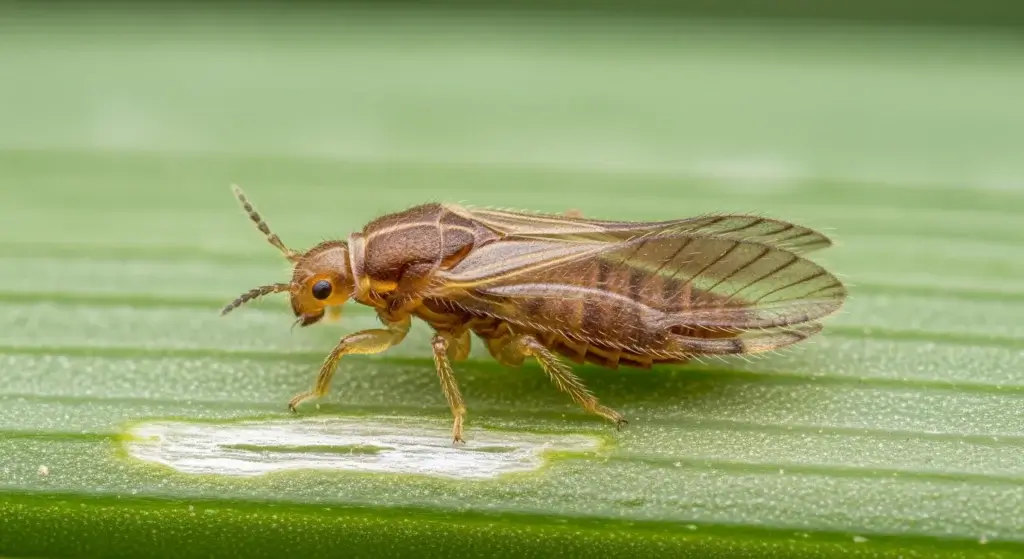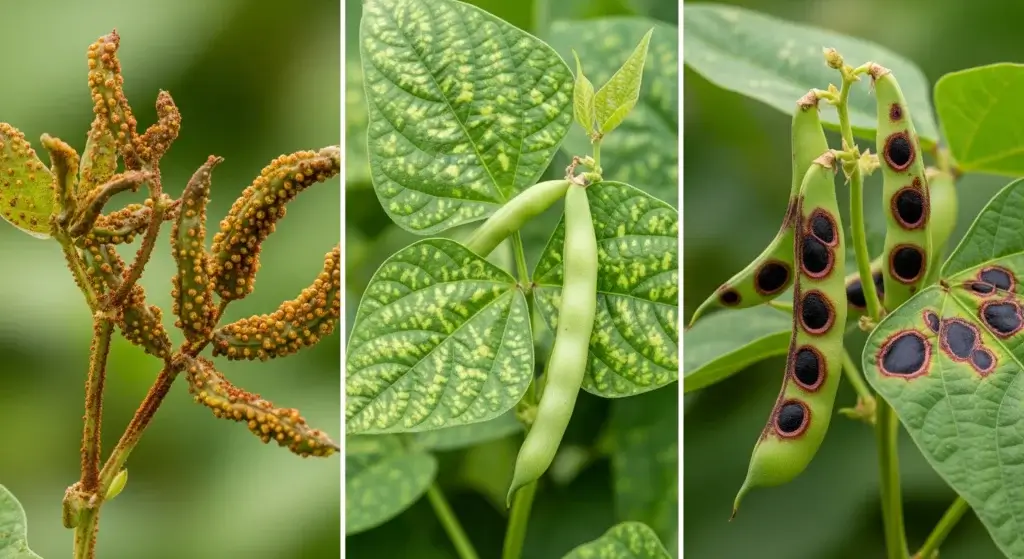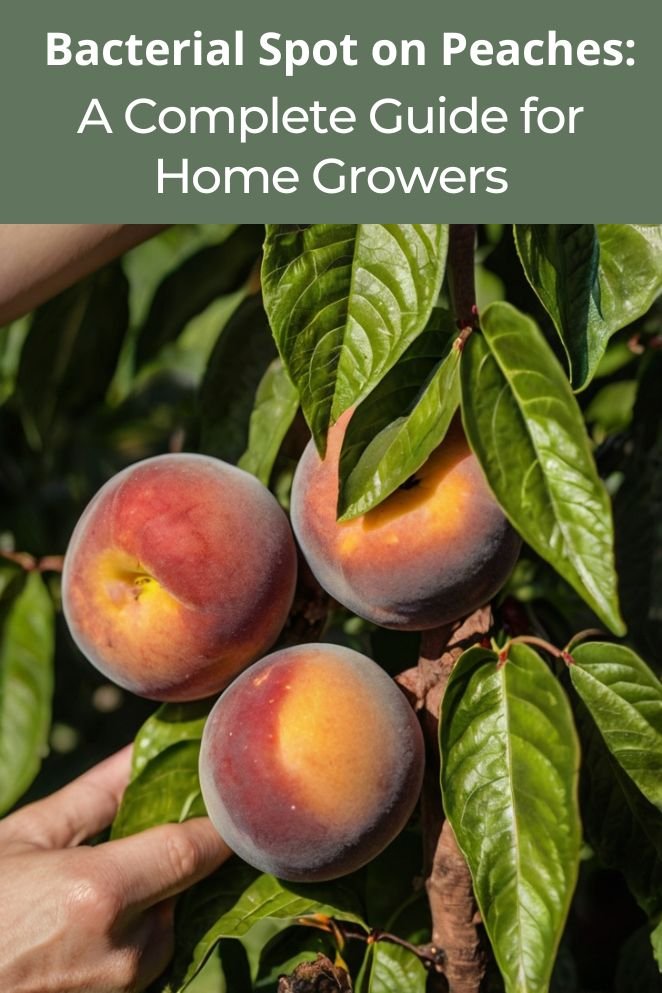
Bacterial spot is a serious disease that affects peach trees, causing significant damage to both the foliage and fruit.
Caused by the bacterium Xanthomonas campestris pv. pruni, bacterial spot can lead to reduced fruit quality and yield, impacting both commercial growers and home gardeners.
Understanding how to deal with this disease is crucial for maintaining healthy peach trees and producing high-quality fruit.
How to Identify Bacterial Spot on Peaches?
Identifying bacterial spot early can make a significant difference in managing the disease.
Here are the key symptoms to look for:
- Read also: Bacterial Spot on Peppers: A Guide to Identification and Prevention
- Read also: A Comprehensive Guide: Controlling Bacterial Spot on Tomatoes
Leaf symptoms
- Small, water-soaked spots: Initial signs on leaves appear as small, water-soaked spots that eventually turn dark brown or black.
- Yellow halos: These spots are often surrounded by yellow halos, which can lead to a shot-hole appearance as the centers fall out.
- Leaf drop: Severe infections can cause premature leaf drop, weakening the tree.
Fruit symptoms
- Rough, pitted spots: On the fruit, bacterial spot manifests as small, raised, rough spots that can become pitted and sunken over time.
- Cracking and deformation: As the fruit grows, these spots can cause cracking and deformation, leading to unmarketable fruit.
- Scabbing: In advanced cases, the fruit may develop scabby lesions, reducing its aesthetic and commercial value.
Twig symptoms
- Cankers: Small, dark lesions on young twigs can develop into cankers, potentially girdling the twig and causing dieback.
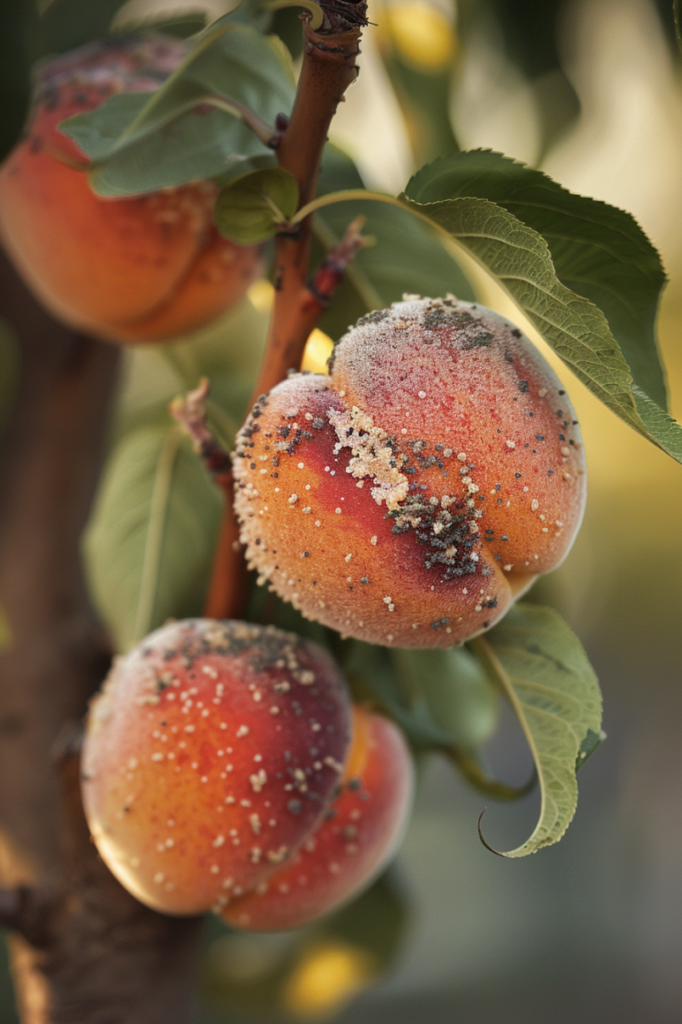
The Impact of Bacterial Spot on Peaches
Bacterial spot can seriously harm peach production, affecting both the quantity and quality of your harvest.
Here’s how this disease can impact your peach orchard:
Yield reduction
Bacterial spot can drastically reduce the number of peaches your trees produce.
Severe infections can lead to significant yield losses, with studies showing that yields can drop by up to 50% in heavily affected orchards.
Fruit quality
The disease doesn’t just cut down the number of peaches; it also affects their quality.
Bacterial spot causes blemishes and spots on the fruit, making them less appealing to consumers.
This drop in quality can significantly lower the market value of your peaches, which is especially important for commercial growers who depend on selling top-quality produce.
Tree health
Bacterial spot can weaken your peach trees over time.
The disease causes repeated defoliation, where the leaves fall off prematurely, and twig dieback, where parts of the tree die.
This ongoing damage can make your trees more susceptible to other diseases and environmental stresses.
Economic losses
All these issues—reduced yields, lower fruit quality, and weakened trees—can lead to significant economic losses for peach growers.
The costs of managing the disease, including using pesticides, increased labor for pruning and removing infected material, and potential losses from unsellable fruit, can add up quickly.
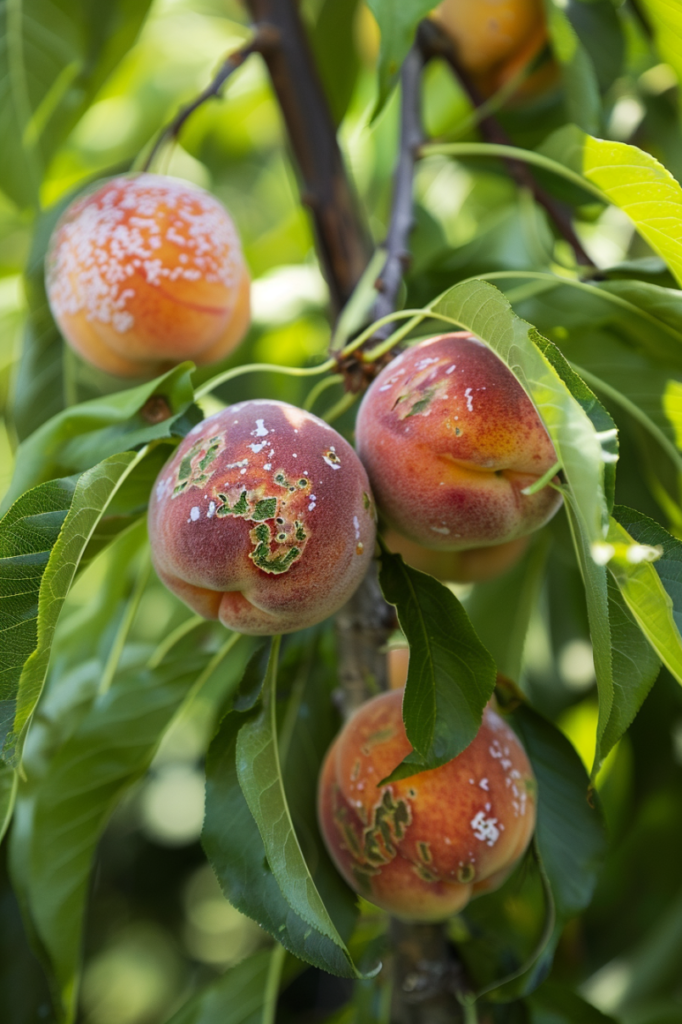
How to Prevent Bacterial Spot in Peaches?
Prevention is the most effective strategy against bacterial spot.
Implementing these practices can help reduce the risk of infection:
Resistant varieties
One of the best ways to avoid bacterial spot is to choose peach varieties that are naturally resistant or tolerant to the disease.
Varieties like ‘Coralstar’ and ‘Redhaven’ are known to be more resistant.
By planting these types, you can lower the chances of your trees getting infected right from the start.
Proper spacing and pruning
Proper spacing between your peach trees is crucial for good air circulation.
When trees are spaced well apart, it reduces humidity levels, which helps prevent bacterial growth.
Regular pruning to remove dense foliage also aids in improving air flow. This not only makes it harder for bacteria to thrive but also promotes healthier tree growth.
Sanitation
Maintaining a clean orchard is key to preventing bacterial spot.
Always remove and destroy any infected plant debris, including fallen leaves and fruit.
This reduces the sources of bacteria that can cause infection.
Think of it as giving your trees a clean environment to grow in, free from harmful bacteria.
Water management
How you water your peach trees can significantly impact the spread of bacterial spot.
Overhead irrigation can splash bacteria onto the leaves and fruit, spreading the disease.
Instead, use drip irrigation systems that deliver water directly to the base of the trees, keeping the foliage dry.
This method conserves water and helps reduce the spread of bacteria.
Integrated pest management
An integrated pest management (IPM) approach can be very effective.
This involves regularly monitoring your orchard for signs of bacterial spot and taking action promptly if you notice any symptoms.
Combining cultural practices like pruning and sanitation with the use of resistant varieties and careful water management creates a comprehensive strategy to keep bacterial spot at bay.
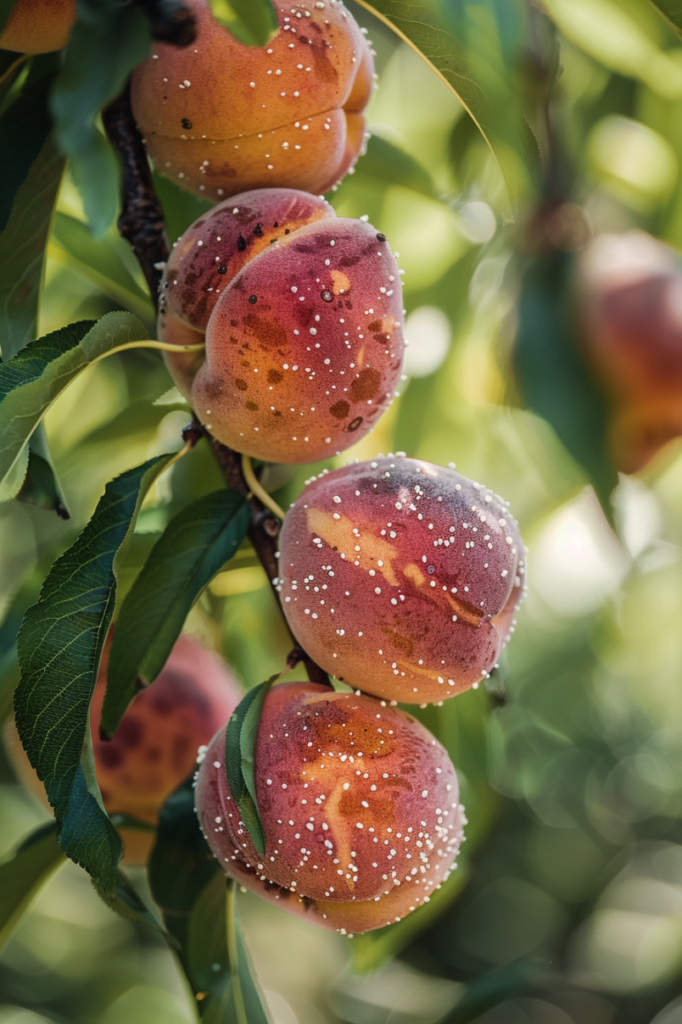
How to Manage Bacterial Spot on Peaches?
If bacterial spot has already found, there are several effective strategies you can use to control its spread and minimize the damage:
Chemical control
Using copper-based bactericides is one of the most common ways to manage bacterial spot.
These sprays are effective if applied correctly.
Start spraying at petal fall and continue through the growing season, following the recommended schedule.
Consistent application helps keep the bacteria in check and protects your peach trees from severe infections.
Antibiotics
In some cases, antibiotics like oxytetracycline can be used to manage bacterial spot.
However, use these sparingly and carefully to prevent resistance and protect beneficial microorganisms in your orchard.
Antibiotics can be effective but should be part of a broader, integrated management approach.
Biological control
Research is ongoing into biological control methods, which show promise for the future.
These include using beneficial bacteria that can outcompete or inhibit the harmful Xanthomonas species causing bacterial spot.
While not yet widely adopted, these methods offer a sustainable approach to managing diseases in your orchard.
Cultural practices
- Tree nutrition: Ensure your peach trees receive adequate nutrients through a balanced fertilization program. Strong, healthy trees can fight off bacterial spot more effectively.
- Weed control: Weeds can harbor bacteria and help it spread to your peach trees. Regular weeding reduces these bacteria reservoirs.
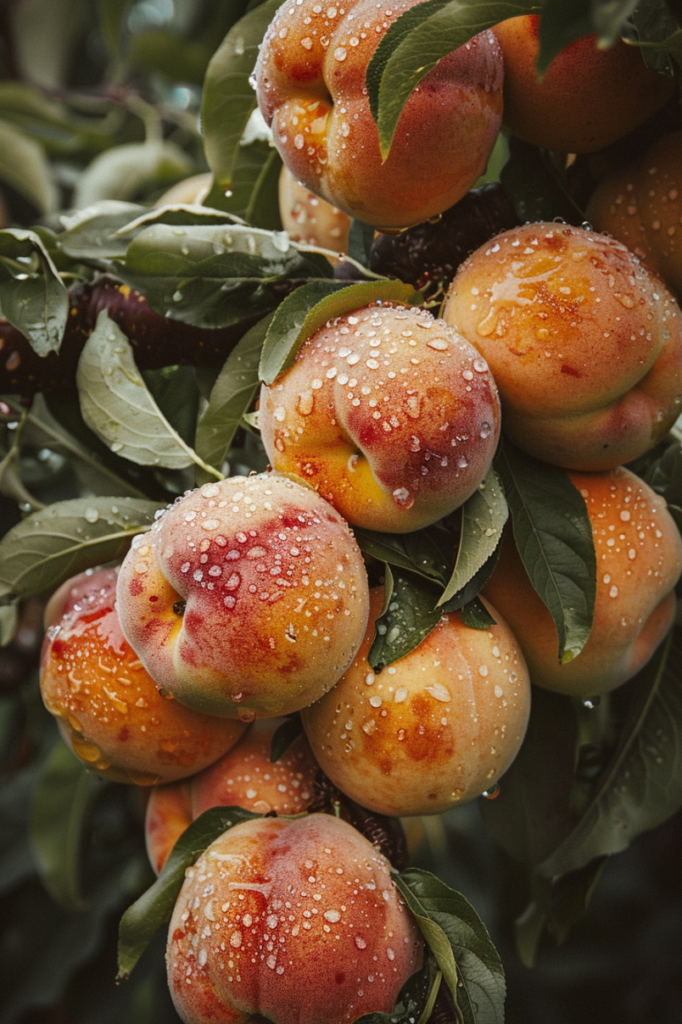
- Read also: Growing Green: Natural Pesticides for Avocado Trees
- Read also: Nurturing Your Orchard: Natural Pesticides for Fruit Trees
Conclusion
Bacterial spot on peaches is a formidable challenge, but with proper identification, prevention, and management strategies, it can be controlled.
By implementing resistant varieties, practicing good orchard hygiene, and using appropriate treatments, you can protect your peach trees and enjoy a healthy, productive harvest.
FAQs
Bacterial spot is caused by the bacterium Xanthomonas campestris pv. pruni. It thrives in warm, wet conditions and can spread through water, infected plant debris, and contaminated tools.
Prevent bacterial spot by choosing resistant varieties, maintaining good orchard hygiene, using drip irrigation, and ensuring proper tree spacing and pruning for good air circulation.
Symptoms include small, water-soaked spots on leaves, rough and pitted spots on fruit, cankers on twigs, and in severe cases, leaf drop and fruit deformation.
Yes, organic treatments include using copper-based bactericides, implementing good cultural practices, and exploring biological control options.
Bacterial spot is not harmful to humans, but it significantly affects the quality and yield of peaches, making the fruit less appealing and marketable.

